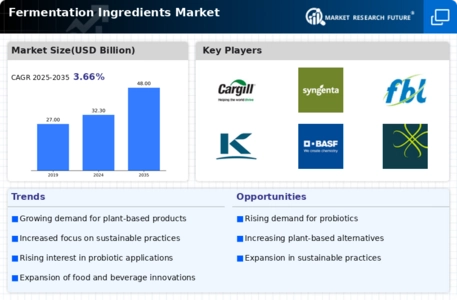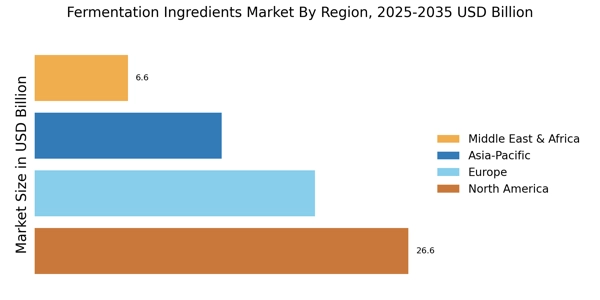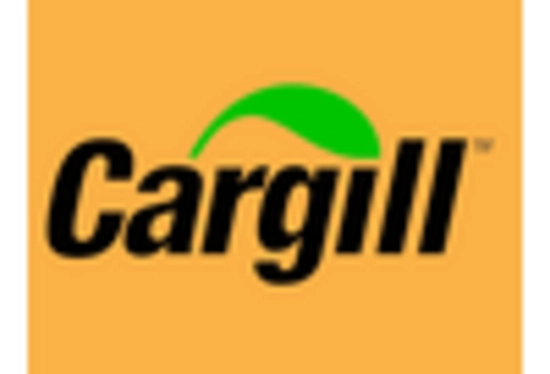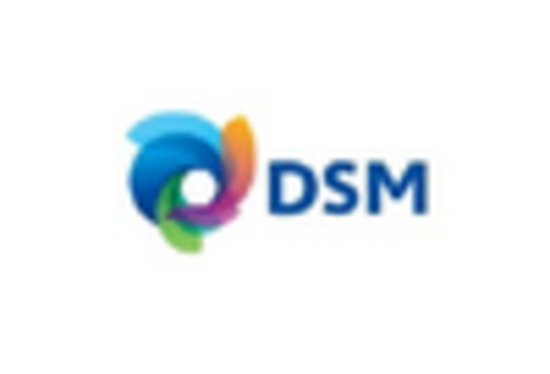Growing Health Consciousness
The increasing awareness of health and wellness among consumers appears to be a pivotal driver for the Fermentation Ingredients Market. As individuals become more health-conscious, there is a notable shift towards natural and organic products. This trend is reflected in the rising demand for fermented foods, which are often perceived as healthier alternatives due to their probiotic content. According to recent data, the market for fermented foods is projected to grow at a compound annual growth rate of approximately 8% over the next five years. This growth is likely to be fueled by the increasing popularity of gut health, as consumers seek products that promote digestive wellness. Consequently, manufacturers in the Fermentation Ingredients Market are focusing on developing innovative fermentation processes to cater to this health-driven demand.
Rising Popularity of Plant-Based Products
The surge in plant-based diets is significantly influencing the Fermentation Ingredients Market. As more consumers adopt vegetarian and vegan lifestyles, the demand for plant-based fermentation ingredients is on the rise. This trend is driven by a combination of health benefits associated with plant-based diets and ethical considerations regarding animal welfare. Data suggests that the plant-based food market is projected to grow at a rate of 10% annually, which is likely to bolster the demand for fermentation ingredients derived from plant sources. Manufacturers are responding to this trend by developing innovative plant-based fermentation products, which not only cater to the dietary preferences of consumers but also align with broader sustainability goals. This shift towards plant-based fermentation is expected to reshape the landscape of the Fermentation Ingredients Market.
Sustainability and Environmental Concerns
Sustainability has emerged as a critical factor influencing consumer choices, thereby impacting the Fermentation Ingredients Market. As environmental concerns escalate, consumers are increasingly favoring products that are produced through sustainable practices. Fermentation processes often utilize renewable resources, which can reduce waste and lower carbon footprints. This shift towards sustainability is prompting companies to adopt eco-friendly fermentation methods, which not only appeal to environmentally conscious consumers but also align with regulatory trends favoring sustainable production. The market for sustainable fermentation ingredients is expected to witness substantial growth, as businesses strive to meet the demands of a more eco-aware consumer base. This trend indicates a potential for innovation in the Fermentation Ingredients Market, as companies explore new ways to enhance sustainability in their production processes.
Technological Advancements in Fermentation
Technological advancements are playing a crucial role in shaping the Fermentation Ingredients Market. Innovations in fermentation technology, such as precision fermentation and bioprocess optimization, are enhancing the efficiency and quality of fermentation processes. These advancements enable manufacturers to produce high-quality fermentation ingredients at a lower cost, thereby increasing competitiveness in the market. Furthermore, the integration of artificial intelligence and machine learning in fermentation processes is likely to streamline production and improve yield. As a result, the Fermentation Ingredients Market is expected to benefit from reduced production times and enhanced product consistency. This technological evolution not only meets the growing demand for diverse fermentation products but also positions companies to respond more effectively to market trends.
Increased Application in Food and Beverage Sector
The food and beverage sector continues to be a dominant force driving the Fermentation Ingredients Market. The versatility of fermentation ingredients allows for their application in a wide range of products, from dairy alternatives to alcoholic beverages. As consumer preferences evolve, there is a growing interest in unique flavors and health benefits associated with fermented products. Recent market analysis indicates that the food and beverage segment accounts for over 60% of the total demand for fermentation ingredients. This trend is likely to persist as manufacturers innovate to create new products that appeal to diverse consumer tastes. Additionally, the rise of craft beverages and artisanal foods is expected to further propel the demand for fermentation ingredients, as consumers seek authentic and high-quality options in their food and drink choices.

















